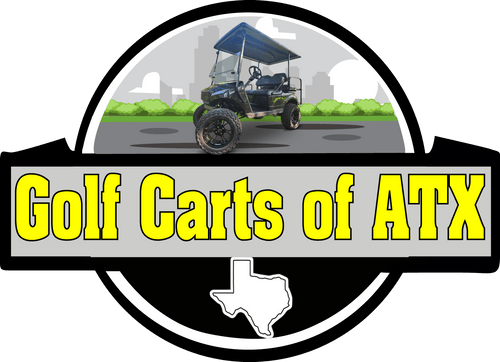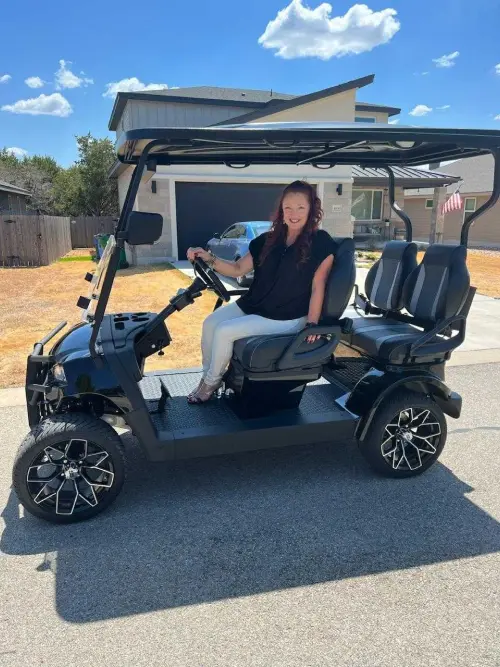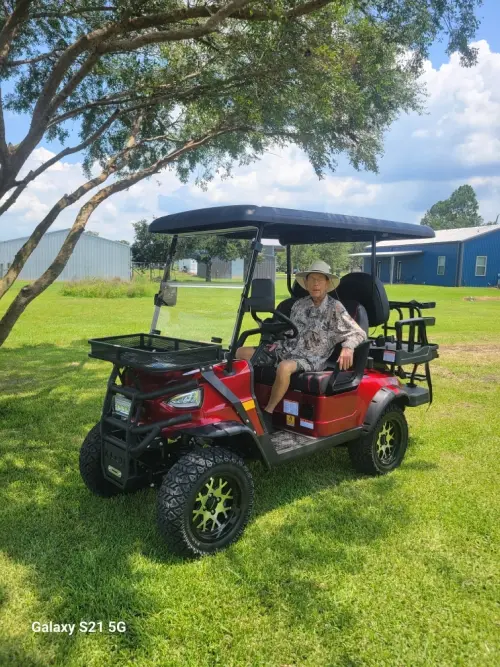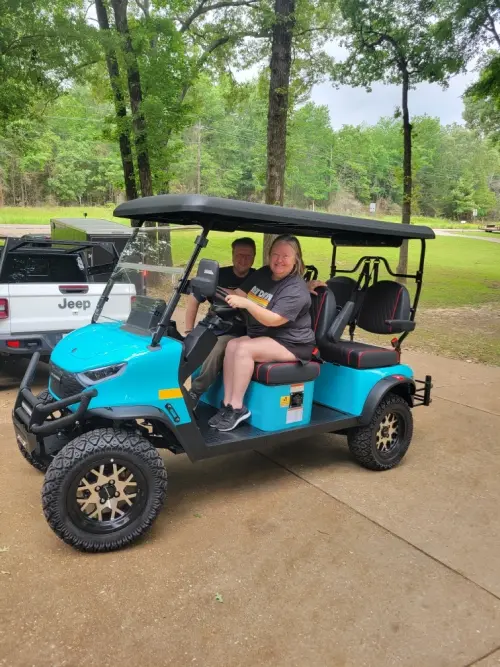
6 Common Golf Cart Problems & How to Fix Them
- Michael
- Golf Cart Tips
How Do I Find Where There Is A Problem In My Golf Cart?
Listen & observe
- Your golf cart may make noises or exhibit other signs of distress. When you attempt to turn it on, is there a sound like clicking? Is it beginning, but finding it difficult to move? These preliminary findings will assist you in identifying the issue's origin.
Examine the Battery
- Many issues with golf cars stem from battery issues. Ensure the battery terminals are free of corrosion, tightness, and dirt. In this case, a multimeter can be your best friend because it can let you determine whether the battery is charged correctly.
Examine the Wheels & Tires
- Underinflated or flat tires can significantly impact your golf cart's performance. Furthermore, ensure the tires are in good condition, and the wheels are mounted correctly.
Examine the Electrical Connections
- Corrupted or loose wires can lead to several issues. Examine all electrical connections while the power is off for anything that seems amiss or damaged.
Fuel System
- If your cart runs on gasoline, check the fuel filter, fuel lines, and level. Clogged or leaking fuel systems can prevent your cart from starting or performing poorly.
Most Common Golf Cart Problems and How To Fix It
Despite their dependability and simplicity, golf carts need help and professional golf cart repair. Knowing the most frequent issues these vehicles face will enable you to prepare for quick and efficient troubleshooting. Keeping your cart in top shape starts with knowing what may go wrong, from battery problems to motor failures. If it is hard for you to do golf cart repair and you do not have sufficient knowledge to do so, call us now. We are offering you a mobile golf cart repair service in Austin!
Battery Problem
- Many issues with golf carts are related to the battery. Considering how vital it is to operate electric carts, any problem here could cause your automobile to become immobile. Common signs and symptoms include the golf cart not starting, losing power quickly, or operating slowly. These issues are often primarily caused by old batteries, poor maintenance, or broken connections.
- How Can I Fix It?
To resolve battery issues, follow these easy steps:
- Seek out obvious signs of leaks or damage. Keep the terminals clean since rust might obstruct the passage of electricity.
- Use a multimeter to determine the voltage. The approximate voltage of a fully charged golf cart battery is 12.6 volts. If the voltage significantly declines, the battery may need to be replaced or recharged.
- Add pure water to battery. To ensure that there is enough water in the batteries that need it and that no low cells are overfilled.
- Another issue that can arise is loose connections. To guarantee correct contact, tighten the cable connectors and battery terminals.
- Fully charge the golf cart’s battery using the charger. It may be time to replace it if it is older than five years or cannot hold a charge.
Ignition Problem
- The ignition system is probably the cause of your golf cart's inability to start. This essential part depends on your golf cart to start, so if it breaks down, you could be stranded on the tee. Numerous things, such as damaged ignition switches, dead batteries, or incorrect connections, might lead to ignition problems. A typical symptom is the golf cart's complete silence or inability to start the engine when the key is turned.
- How Can I Fix It?
- First, confirm that a dead battery isn’t the only issue. Ensure that the battery is fully charged and able to maintain its charge, as a depleted battery might not provide the ignition system with enough power.
- The ignition switch may deteriorate or break with time. When the key is in the “on” position, use a multimeter to check for continuity. It may be necessary to replace the switch if there is no continuity.
- The solenoid is crucial to the starting process as it conduits the electric current to the starter. Check for a clicking sound when you turn the key; if none occurs, there may be a solenoid problem. The solenoid can be tested with a multimeter to ensure it is operating correctly.
- If the solenoid, battery, and ignition switch are all functioning properly, the starter may be the issue. If a starter is not engaging or making grinding noises, it could need to be replaced or repaired.
- Finally, examine each wire going to and from the ignition system. Damaged, loose, or corroded wires may prevent the system from operating correctly.
Motor Problem
- A motor problem is another frequent problem that could prevent your golf cart from operating smoothly. This may manifest as the golf cart struggling to start, experiencing power loss when under load, or ceasing to move altogether, even when the battery is fully charged, and all connections are secure. When something goes wrong with the motor, which is your cart's powerhouse and converts electrical energy into mechanical power, it can feel like your cart's heart has stopped.
- How Can I Fix It?
Motor challenges may evoke fear, but there are steps you can take to detect and potentially address them:
- Start with a visual check for physical damage or overheating, which can cause visible harm to motor components.
- Inspect the brushes on the golf cart motor, mainly if they’ve been in use for years, and replace them if they are worn. Ensure all motor connections are secure and free of corrosion.
- The solenoid, acting as a switch, is crucial for motor startup. Clicking noise during startup suggests the solenoid is engaged, but if the motor doesn’t start, the solenoid or its connection to the motor may be faulty.
- Consider using a multimeter to assess the motor’s input and output for more advanced diagnostics. This involves measuring the voltage at the motor terminals to confirm power reception.
- If previous methods fail or you require guidance, seek expert help. Motor issues can be complex, necessitating specialized knowledge and tools for a lasting solution.
Solenoid Problem
- The solenoid, an electrically triggered switch that regulates the power flow from the battery to the motor, is an essential relay in the complex electrical system of your golf cart. The most frustrating issues arise when the solenoid fails: your golf cart may not start or stop during a ride. Sometimes, there is a discernible clicking sound when the accelerator is pushed, but the car is still stationary, the telltale sign of a solenoid issue. Due to the overlap of symptoms, this ailment is sometimes misinterpreted as a motor or battery problem.
- How Can I Fix It?
Effectively addressing a solenoid issue involves a combination of observation and action:
- Start by visually examining the solenoid for signs of damage or wear, such as discoloration indicating overheating or physical harm.
- Ensure all electrical connections to the solenoid are secure and clean, as loose or rusted connections can hinder performance. A multimeter checks the solenoid for continuity by placing probes on its terminals. Without pedal pressure, there should be no continuity; with pressure, continuity should be present. Divergent results may indicate a defective solenoid.
If testing confirms solenoid defects, replace the part by disconnecting the battery, removing the old solenoid, and installing a new one. Ensure proper reconnection of wires and terminals for compatibility and optimal performance. - If uncomfortable performing tests or replacement, or if issues persist after these steps, consult a specialist for a thorough diagnosis and resolution.
Speed Control Issue
- Since golf carts are designed for leisurely travel around walkways and greens, speed control is essential to their efficient and safe operation. On the other hand, if a golf cart starts to show signs of speed control issues, like sudden surges, poor acceleration, or difficulty reaching regular speeds, there is a problem with the speed control system. This system may include a speed controller, potentiometer (pot), or other electronic speed control devices, depending on the model of your golf cart. It is essential to locate and fix issues in this intricate system if you want your golf cart to run smoothly. Are you looking for mobile golf cart repair? Call us now!
- How Can I Fix It?
- Begin by inspecting the potentiometer to see if your cart is equipped with one. This component communicates your desired speed to the controller. Check for wear, corrosion, or damage that could affect its operation. A multimeter tests for continuity and resistance changes when pressing the accelerator to determine if the potentiometer is functioning correctly.
- Based on accelerator input, the speed controller manages the power flow from the battery to the motor. Visually examine it for signs of damage or overheating, which may indicate a malfunction. A diagnostic test, typically performed with specialized equipment or following manufacturer guidelines, can identify controller issues.
- Inconsistent speed control may result from improper wiring or loose connections between the accelerator, potentiometer, and speed controller. Ensure all connections are secure and wires are in good condition, replacing worn or damaged ones.
- Minor adjustments or recalibrations to the controller settings can resolve some speed control problems. Consult the manufacturer’s instructions for guidance on making these changes safely and accurately.
- If the methods mentioned earlier fail to resolve the issue due to the complexity of the speed control system or potential electronic defects requiring specialized equipment, seeking professional assistance may be advisable. A qualified technician can conduct a comprehensive assessment and effectively repair defects with precision and expertise.
Direction Switch Problem
- A direction switch issue on a golf cart can be incredibly confusing since it can cause unexpected hesitations or failures while attempting to change directions and make it impossible to convert between forward and reverse motion. This switch, necessary for your golf cart to function, ensures that the engine receives electricity from the battery in the proper direction to move the cart forward or backward. Misfunctioning direction switches can be caused by mechanical wear, electrical issues, or just dirt and debris getting in the way of the connections.
- How Can I Fix It?
- Inspect the direction switch thoroughly for visible wear, damage, or corrosion. If physical damage is present, consider replacing the switch entirely.
- Over time, dust or rust may accumulate on the switch contacts, leading to reduced electrical conductivity. Cleaning the contacts with an appropriate electronic cleaner can help restore proper function. Remember to turn off the golf cart and remove the keys to avoid electrical shock before cleaning.
- Check for faulty or loose wiring connections to and from the direction switch, which can cause operational issues. Ensure all connections are tight and in good condition, tightening any loose ones and replacing any damaged wires.
- Once the switch is cleaned and connections are secure, test its operation. Use a multimeter to check for continuity in both forward and reverse modes. A lack of continuity in either position indicates a malfunctioning switch.
- Replacement is often the best solution if the switch is damaged or fails continuity tests. Ensure the replacement switch is compatible with your golf cart model. While switch replacement is typically straightforward, exercise caution to ensure all connections are correctly reestablished.
- If the problem persists or you’re uncomfortable performing these repairs, seek assistance from a professional technician. A certified technician can diagnose and address any underlying issues that may not be immediately apparent.
Are you tired of dealing with unreliable golf cart repair services? Say goodbye to the hassle and trust Golf Cart of ATX, your premier destination for all things golf cart-related. As the leading golf cart dealer in Austin, we take pride in offering a comprehensive range of services, including mobile golf cart repair. Our team of skilled technicians is equipped to handle any repair or maintenance needs your golf cart may have right at your doorstep. With the Golf Cart of ATX, you can rest assured that your golf cart is in good hands. Contact us today and experience the convenience and expertise that sets us apart!







